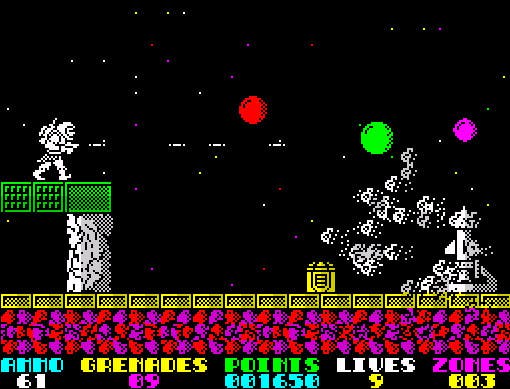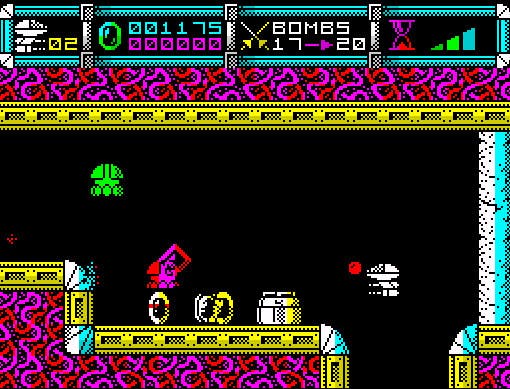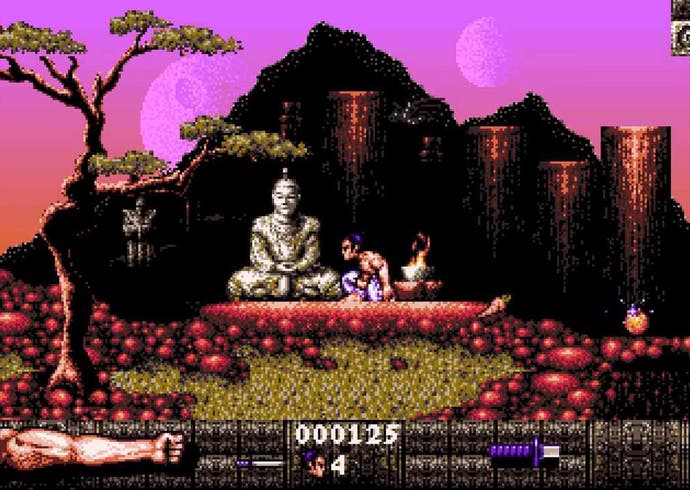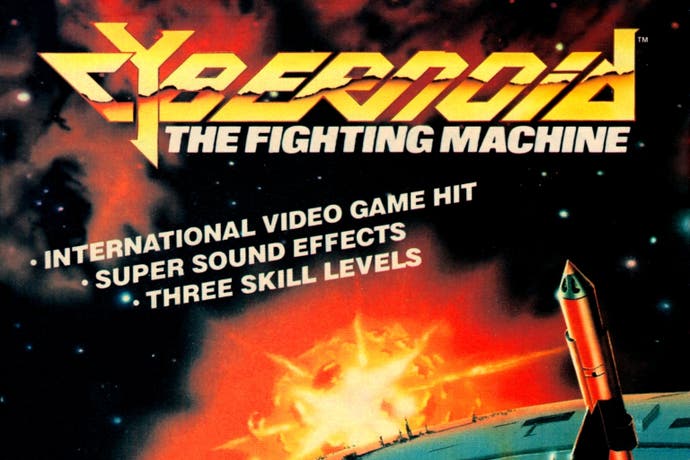Code Britannia: Raffaele Cecco
The last 8-bit superstar on the limits of the Spectrum, developer diaries and the refreshing nature of boring stuff.
Code Britannia is an ongoing series of interviews with seminal British games designers, looking back over their careers and the changing face of gaming.
Rafaelle Cecco came to the 8-bit gaming scene relatively late, compared to his peers. His first published game didn't come out until 1986, four years after the launch of the ZX Spectrum when Sinclair's home micro was at its peak. Only a few years after that the 8-bit era was in terminal decline, but as arguably the last of the name-brand Spectrum developers, Cecco's small but perfectly formed body of work helped to define the late 8-bit era.
"I first encountered games in the arcades near school through Space Invaders and Galaxian," Cecco explains. "I loved all the early games - Galaga, Defender, Phoenix... I was never that great at playing them, but was engrossed by the sound and movement. I couldn't think of a better thing to get into, really."
While others of his generation shovelled their pocket money into arcade cabinets, 10p at a time, Cecco was lucky enough to have access to a very early - and very obscure - games console, courtesy of the now-quaint idea of renting your TV set. "My parents were given a Videomaster Superscore as part of a TV rental deal," he recalls, "and I remember being fascinated by how this thing worked and could react apparently intelligently to my input." Even at school, he was able to indulge his burgeoning love for games, thanks to an open-minded teacher. "We had some some Commodore Pets, with the small green screen. Our maths teacher allowed us to play Space Invaders on them, thus showing me what computers were designed for."

It was inevitable that the technologically minded young Cecco would try his hand at coding, but it took a while for his ideas to be recorded in a usable state. "The first computer I owned myself was a Sinclair ZX81, black and white with 1024 bytes of ram. I learnt how to program in BASIC on that machine, but could never save my work as the tape loading was atrocious. I really learnt how to program properly in machine code on the Sinclair Spectrum."
As for the great playground rivalry of the 1980s, Cecco was Speccy from the start. "I'm not sure if the C64 was even out at the same time as the Spectrum in the UK, as I don't remember even considering it as an option," he muses. In actual fact, they were out at the same time, released only months apart in a thrilling foreshadowing of the PlayStation 4 and Xbox One but the C64, with its fancy colourful graphics and American swagger was the more expensive option. "I suppose the Spectrum was the only contender at its price point," agrees Cecco. "In retrospect, choosing a Spectrum over a C64 would have been an odd choice as the C64 was more advanced with hardware assistance for graphics and sound."
Cecco wouldn't actually release a commercial game until 1986, when he was 19-years-old. At a time when it was common for developers to start out in the business while still at high school, that made him something of a latecomer by the standards of the time. "It was hugely exciting, getting paid - a small amount - for doing my hobby," he says. "It also coincided with me leaving home at 18 to go and work at MikroGen, so big changes all round really. It was great interacting with other programmers, who were all better than me at the time, as prior to that all my tinkering had been quite a solitary affair."
Cecco produced two games for MikroGen, the company best known for the Wally Week adventures. Equinox cast the player as a maintenance droid, tasked with cleaning up eight sectors of a space station obstructed by a malfunctioning security system. No great shakes in the originality department, but it was a foot in the door and offered a gameplay model that Cecco would refine later for his first true hit. "Equinox was a pretty good game that reviewed well," Cecco explains. "It was my first commercial game, and I was very happy with it. There are some early indicators of Cybernoid in Equinox if you look closely." Before we move on to Cybernoid, and the arrival in the gaming consciousness of Raff Cecco, superstar developer, there's the small matter of his second - and final - title for MikroGen, however.
By 1986 the company was in financial trouble, having sunk around £130,000 into the Mikro Plus peripheral, which boosted the Spectrum to 64k of usable memory. Only one game - Shadow of the Unicorn - was ever published to take advantage of the device, however. Cecco moved on, delivering the crime-themed shooting gallery CopOut on the way out. "CopOut was a title that I did out of good will for MikroGen after I left them to become freelance and work for Hewson," he recalls. "I don't think they were too pleased I was leaving, and it helped smooth things over a bit."
CopOut does at least have one minor claim to fame. It was chosen as the game of choice for the televised National Computer Games Championship at the end of 1986. It's not actually all that bad - a little bland and repetitive, but given how bad some 8-bit games could be it's playable enough. Cecco, however, isn't fond of it. "It was probably my worst game, in all honesty," he confesses.
"The Speccy was just so slow, with zero hardware assistance for drawing graphics,"

Cecco ended up working for Hewson Consultants, a well established software house with a reputation for nurturing distinctive development talents - Andrew Braybrook coded his C64 hits for them - and canny PR campaigns. Founder Andrew Hewson wrote the popular programming book, Hints and Tips for the ZX80, and also had a regular column in Sinclair User magazine. It's perhaps no surprise that Exolon, Cecco's first game for Hewson was treated as a major event, with Cecco himself pushed to the forefront of the promotion and treated as the saviour of a home computer scene that, while healthy, was in danger of being eclipsed by arcade games that were proving harder and harder to port to the wheezing Spectrum.
For eager gamers gazing at Exolon's confident sprites, busy explosions and colourful graphics, the name Raffaele Cecco quickly took on a celebrity sheen. From the other side of the fence, the effect was less noticeable. "Aside from seeing myself in all the magazines, which was interesting for about two weeks, nothing really changed," Cecco muses. Nor did he feel that his sudden fame brought additional pressure. "It was certainly pleasing to see the good reviews and have all the hard work recognised. Rather than create extra pressure, this tended to give you a confidence boost for the next title."
Mostly, Cecco concentrated on getting the Spectrum's limited technology to do what he wanted it to do - a particular challenge for a developer whose games were now known for their then-sumptuous visuals. "The Speccy was just so slow, with zero hardware assistance for drawing graphics," he grumbles. "Everything had to be done in software with all manner of technical tricks to get things moving smoothly. You had to understand the Z80 processor intimately to get the best performance."
It was around this time that Cecco also took on his first - and only - arcade conversion in the shape of Tecmo's puzzle platformer, Solomon's Key. "It was a fairly easy job not having to come up with gameplay ideas," admits Cecco. "Simply copying what you saw on screen was quite a refreshing break."
It was Cecco's next game that really sealed his reputation as one of the Speccy legends, however. The late 1980s not only saw the rise of 16-bit computers on the horizon, it was the heyday of the arcade shoot-em-up, a genre built around speed, grace and giant boss encounters that an old warhorse like the Spectrum struggled to replicate.
While other poor developers battled to convert the fast-paced likes of R-Type to 8-bit computers, Cecco took the opposite approach. For Cybernoid, he slowed everything right down. Superficially similar in gameplay design to Cecco's debut, Equinox, but with the visual razzle-dazzle of Exolon ramped up even further, Cybernoid took the familiar trope of the lone spaceship fighting insurmountable odds and made it more about patience and carefully timed movements than sheer speed and rapid reactions. The press was suitably impressed. "Who needs 16-bit machines when Hewson and Raffaele Cecco can produce games like this on the 8-bit Spectrum?" gushed Crash.
"MikroGen was famous for it's flick-screen games, and Cybernoid was influenced by that legacy," reveals Cecco. Rather than try to force the Spectrum to scroll beyond its means, he crafted a series of rooms filled with sporadically firing gun turrets and motion-activated missiles. Navigating through these spaces, while still shooting the array of weird floating shapes that drifted in from off-screen, meant that while Cybernoid looked like a shoot-em-up, it actually played more like a platform game.
"It doesn't take a games programmer long to hit the boundaries of any hardware, and it's then it's down to the the usual optimisations and tricks."

"The fact that the main character happened to be a space ship was irrelevant," says Cecco, pragmatically. "It didn't preclude the designing of fiendish set pieces and puzzles just because it was a shooter. Looking back, I suppose it was quite unusual to have a combination of platform elements with a hardcore shooter, although I didn't over-analyse that aspect of it - if it played well, it went in."
Cybernoid was also the first game of Cecco's to spawn a sequel and, in a move that would make even the Activisions and Ubisofts of today baulk, that sequel came out in the same year as the original. Was that a creative impulse to do more with the game, or the potential to make more cash? "It was a commercial imperative to capitalise on the original's success, although it wasn't as cynical as it sounds!" laughs Cecco. "From a development point of view, it meant more bombs, bullets and fun stuff."
With Cecco now firmly established as a name brand developer, Hewson opened the promotional nozzle to full blast for what would turn out to be one of his last projects for both the company and the Spectrum itself. Stormlord looked a lot like a fantasy version of Exolon, with a rugged barbarian hero freeing trapped fairies in a series of platform-esque screens. What made Stormlord notable was that the development process was documented by Cecco himself in a diary for Crash magazine.
Did meeting a monthly deadline get in the way of coding, or did documenting his creative process help to crystallise the ideas? "Hewson was pretty hot on PR, and certainly the Crash diaries were a useful tool in that respect," Cecco reveals. "I was happy to do it and could see the value of it, although I do remember thinking it was another thing on the 'to do' list that I could have lived without. Sometimes it was hard trying to make software development sound exciting. I did the development work first, then wrote about it, so it didn't really help me with ideas or anything; the game would have ended up the same without the diary."
Stormlord 2 followed for Hewson in 1990, but that would be Cecco's last game for the publisher. Instead, Cecco joined Vivid Image, where the man once knighted as the chosen defender of the 8-bit kingdom from the oncoming 16-bit onslaught finally got to work on what was then "next gen" hardware. The game in question: First Samurai.
"First Samurai was a big culture shock," Cecco admits. "[Vivid Image] had a few nice graphics and a brilliantly animated character, but the designer was proving to be unreliable. They found another artist and basically dumped the incomplete design in my lap. Programming the Amiga was a real luxury with all that memory, speed, colours... I can't say I missed the Speccy as all the new technology was so exciting. However, it doesn't take a games programmer long to hit the boundaries of any hardware, and it's then it's down to the the usual optimisations and tricks."
Cecco stayed with Vivid through a few more games - the imaginatively titled Second Samurai and the SNES/Megadrive driving game Super Street Racer - before leaving with a small group of colleagues to found their own studio, King of the Jungle. In this guise, Cecco helped to develop the sadly forgotten PlayStation gem Agent Armstrong (which owes a great debt to Exolon) along with b-movie 3D shooter Invasion From Beyond (which has a ship oddly reminiscent of Cybernoid).

However, in a third act twist that is fast becoming familiar Code Britannia territory, the increasingly corporate games industry, coupled with the escalating costs and time demands of developing for increasingly sophisticated consoles conspired to crush the fun out of games development for Cecco. King of the Jungle was sold to a larger Swedish company, Unique Development Studios, and everything began to fall apart.
"By around 2003, I remember a bit of a downturn in the industry," explains Cecco. "UDS had invested a lot of resources into the Futurama license, and back in the UK we were struggling to find publishers willing to take on original titles, despite the fact we had a brilliant demo at the time. It all collapsed, and I decided that I'd had enough with the games industry. I'd already stopped playing games and decided to take a year out learning about web technologies. I worked on some really boring stuff like e-commerce systems, but for me it was bizarrely a refreshing change!"
Leaving games behind, Cecco dedicated himself to web development instead, creating Javascript plugins that are now used in the websites for companies like Adidas, Toshiba and Sony. "Some of it has become quite ubiquitous, and you've probably been one of my end users without even knowing it," reveals Cecco. Can jQuery plugins scratch the same creative itch as developing a game? "The itch that gets scratched with work like this is complete development autonomy, no publishers or retailers, a widespread customer base, lower risk and various other benefits compared to the games industry that I left back in the early 2000s."
Fans shouldn't be too despondent, though. It seems Cecco's passion for games may have been rekindled. "After a nice Christmas playing some video games with my daughter, I checked out the indie development scene. I couldn't help myself," he says. "I've started developing a game again! It doesn't even have a name yet, but I can say it will be a 3D space shooter with some great flight physics, whites-of-their-eyes space blasting, and some quirky gameplay features. It's a side project, I have no idea where it will take me, but the main thing is that it's a pleasure to develop. It almost feels like working on Cybernoid again."
If you'd like to read more about Cecco's time working for Hewson Consultants, he's one of several contributors to Andrew Hewson's upcoming Kickstarted book, Hints and Tips for Videogame Pioneers.

